
Sailing Vessel Beruta Ship's Log
Transatlantic 3 (single-handed): Curacao (Caribbean Sea) - Faial (Azores)
Preparations

Spanish Waters, Curacao
I have started preparations for the Atlantic crossing soon after I found that my Curacao residency permit was not renewable because I missed the deadlines for the application and had to start the process all over again. The immigration officials did not care for the reasons for missing the deadlines and the lawyers did not mind making more money on a new process.
There have been many things to fix because Beruta was left unsupervised in Cap Cana marina in DR for almost a year where it had many damages. I replaced some running lines before my departure from Dominican Republic but there were couple of more to do, namely the topping lift and the jib halyard. I also redid some 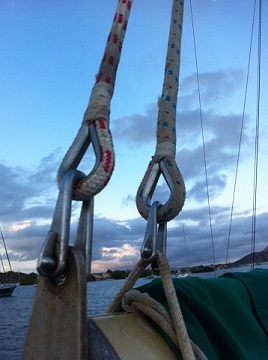 splicing.
splicing.
Glued and screwed broken toe-rail here and there. Ideally it needed to be replaced but on Curacao teak was not available.
The wind generator had both ball bearings gone on the vertical axis. The maker was bought out and the new company did not provide spare parts anymore. I was able to find the bearings in a local Curacao car dealer. The problem was to remove the old ones as all the balls disappeared, there were only two rings left from each bearing. I had tried a few tricks but none of them worked. So at the end I had to make plastic rings from the starboard and insert them in between the old bearing metal rings. It seemed to work. The generator wobbled much less than before. I thought that it was ok because it did not need to rotate much on the vertical axis.
The batteries had suffered sulphation because they were constantly undercharged since my fridge was set to a medium temperature and a solar panel was not enough to keep them up. I was trying to cure them with a higher voltage. I was able to adjust the charge controller to 16 volts and measured the electrolyte gravity every day. There was one cell in each of two batteries shorted. After 3 or 4 days that cell in one battery revived but the other cell in the other battery remained dead even after a month of curing. So I had to replace the battery. At least one. The other one that got a new life after death was still suspicious because the electrolyte was murky, which was a sign of a lead plate destruction. Nevertheless, the gravity was high in all cells meaning that the equalization process succeeded. Therefore, I felt bad discarding the working battery and instead decided to add a new one. So I had three 100-Ah house batteries (two brand new, one old) and one spare (old) for an engine. I liked the addition of the third battery to the house bank. Many times I had to stop the wind generator or cover the solar panel because the batteries were full. And sometimes two batteries were not enough to keep the electronics and the fridge running for one night when there was little wind and not much sun a day before and I had to start the engine early morning to charge them.
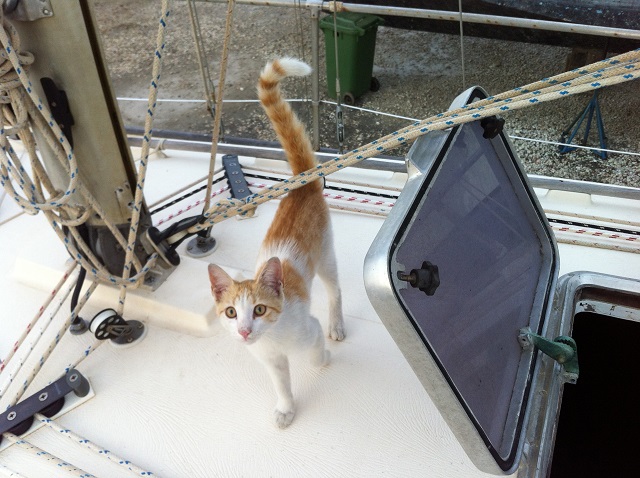
Another thing that bothered me for 5 years (believe it or not) was a manual bilge pump. I inherited it from the previous owner and it was sitting under the bank for long time because I could not figure out where to install it. It was Whale bulkhead-deck mounted model. Another words, it had to be screwed to a bulkhead and a deck at the same time. The only reasonable place I found for it was  in the cockpit. I did not put the strainer at the end of the hose in the bilge and found soon that it was mandatory. A tiny piece of something stuck in the valve inside the pump and it stopped working. I also installed the one-way valve after the strainer. I felt more secure after that. Who knows what might have happened at sea that causes electrical pump to malfunction.
in the cockpit. I did not put the strainer at the end of the hose in the bilge and found soon that it was mandatory. A tiny piece of something stuck in the valve inside the pump and it stopped working. I also installed the one-way valve after the strainer. I felt more secure after that. Who knows what might have happened at sea that causes electrical pump to malfunction.
I had to buy new used dinghy on Curacao because the old one died after a year in DR. It had too many holes to glue. The price for the glue would have been probably the same as for the new dinghy. The new one had a hard bottom, therefore, it was not possible to deflate it, roll and keep on the deck for the voyage. I decided to make  dinghy davits.
dinghy davits.
Engine. I cleaned the fuel tank, well, the one third of it, where I had access. I should have probably discarded the old fuel but since it was filtered I put it back. Replaced the oil and fuel filters as well as the oil. Tightened the belts for a sea water pump and an alternator. Washed the air filter.
The 1.5 kW inverter died just couple of weeks before my departure. Good timing! Put a new one, this time Xantrex 1 kW. Hopefully, it would work longer than the original no-name product from China.
My deck light stopped working. I checked the bulb and it was ok. Then I discovered that the breaker was corrupted. I dismounted my electrical panel and decided to clean and lubricate everything there. I put the breaker plastic panel in the acid and then rinsed it with water. When I put everything together, I used the silicon to protect the terminals from corrosion. During my test, half the breakers did not work. I realized that I had used the neutral bus for a negative one. Ok, that was not difficult to correct. Then I found that the universal tri-color/anchor light strobed when I only turned the tri-color switch on. It was supposed to do so when both anchor and tri-color lights had power. Hm... Eventually (it took me a day or so) I discovered that the breaker plastic panel became conductive! Another words, when I turned on tri-color breaker, there was almost 12-volt voltage on the anchor breaker because it was adjacent to the tri-color one. I had to replace the breaker panel. Would you have ever imagined such thing? The panel had a sandwich construction. Only people in China knew what the material was used for the layers. I guess water got into those layers and shorted them.

My starboard running light was missing in DR. Had to buy a new one. Also the port light was loose, I bolted it throughout to the holding plate.
I replaced two LEDs and 300 Ohm resistor in the compass. They were not protected from water and got corroded. At night, I had seen the course only with a flash light. I used Sikaflex in an attempt to prevent this from happening again.
I was cleaning under the sink in the galley when it stuck me that I did not have a shut-off valve for my potable water tank. If plastic tubing were damaged, then I would have had no means to stop water from draining into the bilge. Had to get and install one right next to the tank.
Leaking ports and the companion way hatch had been an ongoing issue. It seemed like the best way to fix the ports was to get rid of them! The compromise solution would have been to replace them with a frameless windows bolted to the hull via a wide rubber gasket. And as for the companion way hatch - to build a rigid pilot house. So the short term solution was to use Sikaflex between the glass and the frames, duct tape the hatch and use old cloth rags to absorb water near the hatch and paper towels to collect it underneath. No science, sorry.
Galina, a Russian sailing fan from Moscow, a good friend of mine, suggested a perfect way to replace a stolen camera, cell phones and a book reader by iPhone 4. I liked that inexpensive option. I ordered it from Hong Kong. The problem was with customs. I thought that the place where I work was free of duties but of course the cell phones were an exception. Therefore, I did not instruct the people in China to add the key phrase to the address "For sailing vessel BERUTA in transit". Without these magic words Fedex paid customs duties by default and customs officials refused to refund the money saying that their computer program was not designed for it. What a wonderful program! And what a terrific excuse! Well, at the end it cost me almost the same as to buy it in an Otrobanda's local cellular shop.
Royal Marina. Piscadera Bay
The last weekend before my departure I sailed to the Royal Marina located in Piscadera Bay, two and a half hour downwind from Spanish Waters, just passed the Schottegat harbour and Willemstad. I chlorinated the water tank on my way. I used to do it every year or so. The marina is run by a good Venezuelan man. The prices are modest and rules are relaxed. I was the only one who worked on a boat at that time. The only problem was that they did not have a pressure washer and I had to clean the bottom myself using the abrasive pads and a sander. It was tedious and not healthy job to do, I should have told you. Never haul out in the marina that doesn't have a power washing!
The red-and-white furry visitor in the marina (see the photo above) volunteered to be my free-ticket passenger for the Atlantic crossing, a la new Boatsman but I had to say "no" since it meant to be a strictly solo voyage, no crew was allowed.
Sanding is better done when a surface is wet. It is not only safer for breathing and for decks of surrounding vessels (and my pocket for that matter in the absence of a third party liability insurance) but the old antifouling paint is easier to remove with water because it is meant to be ablative that way. The problem was that I neither had a proper sander nor wet sanding paper. In the end, the job was done but the sander almost died. I suspected that water got inside it and shorted the winding. It works but lose the rpm from time to time.

I had cleaned the bottom before I left the Spanish Waters. The weeds came off easily but the remains of barnacles left from a 10-month yacht abandonment in Cap Cana marina in DR during my arrest was very hard to remove even with a scuba tank. One year and a half passed since I antifouled the bottom in Florida last time. I had used the Trinidad paint at that time because SeaHawk Island 44 was not allowed in the US. The Trinidad did not work as well as SeaHawk and after a year it required a new coat. Neither the waterline painted with epoxy paint lasted more than a year. In the beginning of my experience with Beruta I had tried a polyurethane paint and the result was the same.

This time I decided on gelcoat. I had 3/4 of a quart left from my last topside gelcoating job. I just bought the red colorant for it. Well, that was what it said on the bottle. It came out pink as you see. I removed the old waterline with Interlux paint stripper and cleaned it with the fiberglass wash. Sanding actually worked better than the wash. Two layers of gelcoat was enough.
The SeaHawk Island 44 is unbelievably expensive. I could only afford two 1-gallon cans and two bottles of tin booster. Island Water World had blue and black. Since the last paint was blue, I got black. I used the rollers with the shortest hair available for thin and smooth coating. One can was enough for one coat.
If you ever happen to be in Royal Marina, be aware that you would need to tie the stands with your own lines or chain. It is a protected area surrounded by couple of hills but occasionally there are gusts of wind. My stands were short, and they used blocks of wood to support Beruta. With wind gusts the stands tend to move outward and if the blocks fall off, then there is nothing to hold the hull. It will crash in a moment. I also put four pairs of stands instead of three, so I could sleep better.
I found that two  bronze bolts that hold
bronze bolts that hold 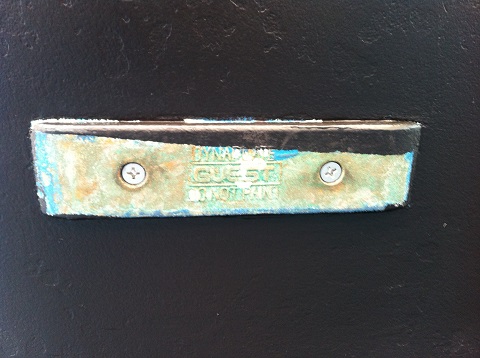 the bronze plate for lightning protection beneath the hull corroded. Strange. I was not able to find bronze bolts of this size on Curacao. So I replaced them with stainless, which is more or less galvanically compatible with bronze.
the bronze plate for lightning protection beneath the hull corroded. Strange. I was not able to find bronze bolts of this size on Curacao. So I replaced them with stainless, which is more or less galvanically compatible with bronze.

The engine had played a bad trick with me when I was returning from Piscadera Bay. It stalled about 30 minutes later after I had left Piscadera. So I had to tack for 4-5 hours against 25-30 kt wind back to Spanish Water, enter the narrow passage under the sails and anchor in the busy anchorage also under the sails. I did it but was a bit nervous first when the wind became almost on the nose in the narrow, shallow and rocky entrance to the Spanish Waters and second when the main picked up the wind and the anchor chain started running and I could not hold it. Had to run back to the tiller and steer against the wind hoping that I would not hit other boats around.
I still don't know the exact reason for the engine failure. I suspect the air in the fuel system. Initially I thought that the fuel filter got clogged but after inspecting it I changed my mind. It was clean and the engine worked with it after I got rid of the air. I spent couple of hours trying to locate the source of that air. Apparently, it is sucked from the 30-micron Racor fuel filter assembly. I should mention that I have two of them: one as a spare. They both leak the air somewhere. That air is supposed to be filtered by the fuel feed pump before the fuel gets into the second 10-micron fuel filter and then into the fuel injection pump. I thought that maybe the 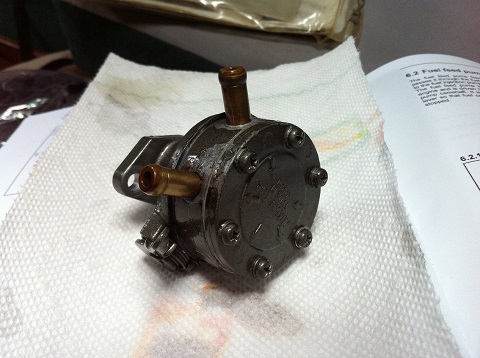 fuel feed pump was defective. I took it out and apart. It seemed to be ok. It works anyway. I put clear tubing before and after the pump. I could see that there was plenty of air coming into it and no air going out. Interesting though where does that air go? Could it be just the vacuum? Hm...
fuel feed pump was defective. I took it out and apart. It seemed to be ok. It works anyway. I put clear tubing before and after the pump. I could see that there was plenty of air coming into it and no air going out. Interesting though where does that air go? Could it be just the vacuum? Hm...
Spanish Waters, Curacao
I have planned this trip to be the longest one: approximately 2,700 nautical miles on a great circle where in the reality it will be longer because first I need to sail from the Caribbean sea somewhat north to the middle latitudes (35-38° N) where one would expect prevalent down wind sailing straight to Azores. The best estimate in number of days was 25 but it may be close to a month or more. I will cross the windless area of high pressure in 25-30° N where I would burn most of my 240 liters of diesel.
During my two previous Atlantic crossing I was on a safe side and took provisions for at least two months. The first crossing from St. Martin to Flores, Azores was 19 days and on the way back from La Gomera, Canary Islands to Barbados I spent at sea exactly 3 weeks. I had always had lots of stuff left. Therefore, this time I decided to be more economic and calculated my food for one month. Of course, something will always stay after a month, so I won't be starving. I have 350 liters of water or so, plus juices, milk and other drinks.
Thanks to my African-Italian friend Monica who helped with provisioning driving me to various supermarkets in Willemstad. Without a car, it would have taken me a few bike trips over two or three days.
On my last day I helped Maxim, the Russian crew member of Mary Galante, the sailboat on hard in Curacao marina, who just arrived from Moscow to prepare the boat for selling. I and Monica helped him with English translation in the marina, accommodations and car rental. He asked me to get him a local SIM card. We made a stop in a cellular outlet for it and oh, goodness, they had waterproof cases for my new iPhone, Lifeproof! The only color that left was purple though. They sold the pink a day before; otherwise, it would have matched Beruta's waterline. Ha-ha.

24 May 2014
Woke up at 6AM local time, just a few minutes before sun rises in Spanish Waters, Curacao. It is important to pull the anchor early before the wind picks up to its normal 30-knot plus gust range, which usually happens half an hour after the sun is up.
Most things have been ready like the  outboard was hung on the stern railing and stuff was stowed away in the cabin. I prepared both sails for hoisting and launched the dinghy, in which I was trying to glue couple of holes last night. It requires 72 hours for the glue to set according to the instructions that I did not have. Hence, I just taped the patch around the inflatable tube (both holes were conveniently located at the stern) and pressurized the tubes with air. If it works - great! Otherwise, I would have to jump into the dinghy at least once a week to pump it. That would be quite an adventurous if not to say risky, trick to do at sea.
outboard was hung on the stern railing and stuff was stowed away in the cabin. I prepared both sails for hoisting and launched the dinghy, in which I was trying to glue couple of holes last night. It requires 72 hours for the glue to set according to the instructions that I did not have. Hence, I just taped the patch around the inflatable tube (both holes were conveniently located at the stern) and pressurized the tubes with air. If it works - great! Otherwise, I would have to jump into the dinghy at least once a week to pump it. That would be quite an adventurous if not to say risky, trick to do at sea.
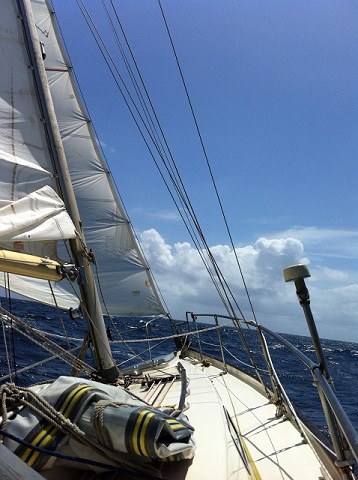
 The dinghy davits that I made couple of weeks ago proved not to work mostly because the size of my hard-bottom inflatable was too big. Both stern and bow went beyond the sides of Beruta and at a heel caught the waves and water. And because there was no space for it on deck, I had no other choice as to tow it across Atlantic all the way.
The dinghy davits that I made couple of weeks ago proved not to work mostly because the size of my hard-bottom inflatable was too big. Both stern and bow went beyond the sides of Beruta and at a heel caught the waves and water. And because there was no space for it on deck, I had no other choice as to tow it across Atlantic all the way.
At 6:30 the wind started already gusting, but I was able to pull the anchor by hand.
I was afraid of the same situation that might happen when I go out of Spanish Waters through the narrow channel. Usually it blows right into the nose on the exit. That was the reason to have both sails hoisted before the exit and hoped that the wind would be a little on the port side. I also opened the valves of both fuel filters, just in case; not to mention that I discarded 3 gallons of old diesel a day before and filled the tank with brand new fuel with biocide and performance additives. The wind actually was on the port side. Even if the engine had stopped at the wrong moment, I could have still sailed out of this channel into the sea.
Close to 7AM I was outside of Spanish Waters, stopped the engine and start tacking to the east. The wind was 20 to 30 knots. I have two reefs on the main, and the jib. Tacking on the port side was difficult because Beruta was going into the waves but starboard side was easy. Two and a half hours later after 4 or 5 short tacks I passed Curacao east end and headed towards Bonaire. My chartplotter was showing that I was steering to Antigua! Wow, I have never thought that I could cross the Caribbean sea diagonally. But by the time I was close to Bonaire the situation changed, and I was dragging by the current towards Puerto Rico. Also the waves got steeper and I have to bear away to 50-60° to save Beruta from nasty falls.
Ideally I would like to pass Puerto Rico on the east side but after a few things got broken including the toilet seat, the mirror in the head and the joystick button on the chartplotter, I realised that I would be lucky if I could do it on the west side. Of course, I wanted to be closer to Puerto Rico than Dominican Republic and stay in international waters all the time. So I kept steering 50° to the wind as much as possible to avoid all the trouble with corrupted Dominican authorities again.
Autopilot was doing its thing - counteracting the waves and not returning the boat to its course fast enough. Maybe I should have changed the sensitivity from 2 to 1 but instead I just tied the tiller and put the Raymarine toy on a standby. Beruta autosteers upwind very good, just set the sails and be done with it. I had to let the main to flap a bit to deal with the windward helm. Definitely, this loses a bit of speed but, oh well, the sailing (as well as a life) is about compromises, isn't it?
All day long I felt sleepy, either because had not had much sleep last night or because of motion. I was born lucky not to be susceptible to sea sickness. I'm truly sorry for those folks that love sailing but have to cope with the motion. When the night came the wind was steady 25 gusting to 30. I wanted to have a good rest and took the main down. Less worries in moonless darkness. Nevertheless, I had hardly had a nap. Maybe because of the first night and autopilot. I put it to work with the jib to windsteer 50°. Therefore, it was annoying me with beeping anytime the wind shifts. This beeping is easy to confuse with an AIS alarm. So I had to go and check to make sure there was not a collision situation.
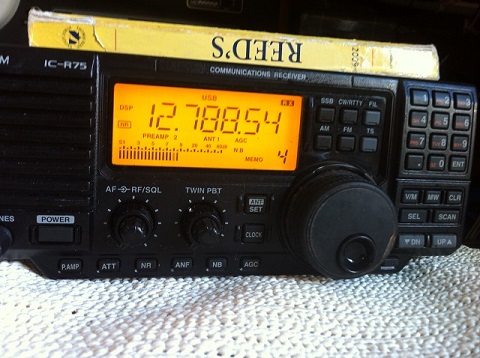
25 May 2014
The wind became weaker, just gusting to 25, so sailing with half the main and the jib was comfortable enough. The eastern current was still strong, around 1.5 knots or more and slowed me down considerably.
I did not want to make any tacks while going to the Atlantic, so I had to sail close hauled all the time to avoid Dominican Republic shores. From time to time it appeared that I could have passed Puerto Rico on the east side but the closer I got to the US territory, the more obvious it was that I had to go via Mona passage, the same place where I was arrested last year when visited my daughter Yana who lives in DR, "for international drug trafficking". A Dominican jail is not the place where anyone wants to be, so the best I could do was to pass the strait on the other side near the US land.
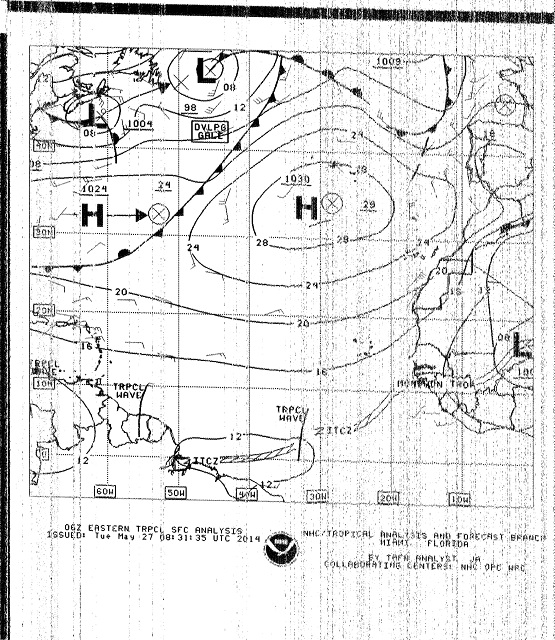
26 May 2014
I have finally learned how to receive weather faxes! It was great! I wish I knew how to do it before, i.e. during my first two transatlantics. The main trick was to fine tune the HF receiver, not in terms of frequencies but in terms of filtering the noises. As you may see on the picture of the screen of IC-R75, I used Preamp 2 for improved S/N ratio and sensitivity, NR, which reduces noise components through the optional UT-106 DSP, and AGC that keeps the constant audio output level. The most noticeable effect on the quality of audio signal was achieved though by varying Twin PBT function, which narrows the IF passband width to reduce interference.
The other trick was to use a microphone cable for signal input rather than a microphone. I had to make it myself from two headphone cables. One was a mono/stereo headphone cable and another was a stereo with a microphone built-in and therefore, had an extra ring on  the jack for it that works with a laptop audio input/output. So basically I soldered the wire of the mono cable to the microphone's wire.
the jack for it that works with a laptop audio input/output. So basically I soldered the wire of the mono cable to the microphone's wire.
I use JVComm32 application and it worked really good for me in HF-FAX mode out of the box without any adjustments. I receive New Orleans (call sign NMG) weather station on 12,788 kHz frequency in USB mode (that is the carrier frequency, the assigned one is 1.9 kHz higher or 12,789.9, which I think is only good for dedicated radio-fax machines). The broadcast times are given in the NOAA book called Worldwide Marine Radiofacsimile Broadcast Schedules.
You may judge the quality of my reception yourself. I will try to post them from time to time here.
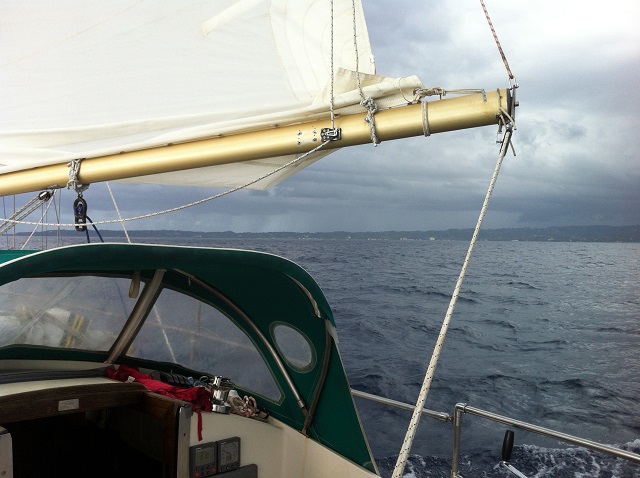
27 May 2014
At sunrise I could see the mountains of Puerto Rico on the horizon. It was still 30 miles to the Mona Passage.
Around noon local time I was entering the territorial waters of United States. Because of two US small islands between Puerto Rico and Dominican Republic it would have been impossible to stay in the international waters on my way to the Atlantic. Each island adds 12-mile radius circle to Puerto Rico's territorial waters. Couple of hours later I heard the noise of a power boat coming from the shore towards me. Yes, that was what I thought, the police. Almost like a year ago, when the Dominican DNCD police arrested me in their waters.
I was calm, mostly because I was certain that it would not have happened again, at least not in the American part of Mona passage. The police boat kept a good distance from me. They hadn't even tried to hail me on VHF. The officer waived and then from 50 yards or so shouted a question where I was going. I had to repeat twice really loud, so he could hear me. I said that I was going to cross the Atlantic to Azores. He replied okay and the boat went back to where it came from, the shore. I wish the Dominican police had learned the sea rules of peaceful voyages across territorial waters from their American neighbor.
The depth in Mona strait is shallow, from 5 to 25 meters. I decided to fish. After the second barracuda splashed the Beruta's cockpit with lots of blood, I stopped this entertainment and heated the chicken legs with potato. After all, wasting good Cuban rum for fish narcosis was senseless to me, especially on the fish that I would not eat. The prospect of getting blind or having colors reversed due to siguaterra in the middle of Atlantic did not appeal to me much.
I was lucky with the current in Mona strait. It helped with 6-8 knot downwind sailing by adding about one knot. Close to the end of the passage the wind changed to abeam on the portside, then closed-hauled and then died completely. For the first time I had to start the engine. A US police airplane made a circle around Beruta and headed back to the land.
After a hour motoring, the east wind blew from Atlantic 15 to 20 knots. I stalled the engine, took one reef off the main and was thinking to change the jib with genoa but then it picked up to 25-30 knots and I had to take the reef again and when Beruta was fallen hard from the irregular waves, took the main down. The current was strong, I was making over 7 knots. The Caribbean sea spitted me out to unfriendly Atlantic. On the weather charts there was 10 knot wind south of Puerto Rico and 15 knot wind north of 20°N. I had hoped that the strong wind was over but instead it was the same as when I was leaving Curacao. It might have been some kind of land effect of course, because behind me there were lightnings on a black skies. I had not seen thunderstorms for long time. On Curacao spring time is dry and sunny.
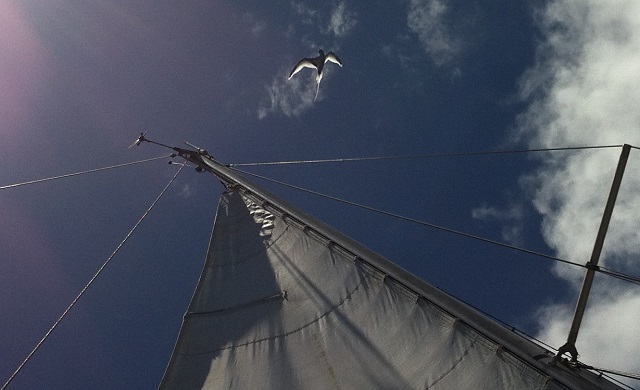
28 May 2014
7:00AM local time. The distance over ground showed by the Raymarine chartplotter was 479 nm, about 50 miles less than the distance through water. Those miles were lost in the Caribbean sea when attempting to sail as much to the wind as possible fighting the eastern current. Also, probably 10 of those 50 were lost during tacking against the wind when rounding east point of Curacao. Ah, no, sorry, these 10 were taken into account in the GPS track. The good news were as you may guess, that I was still on track for average 120 nm a day, or an average speed of 5 knots. The following current in the Mona passage helped to get it.
For a breakfast today was a cereal with milk and coffee with cookies. Then a dose of vitamins before lunch: banana, an apple and grapes.
During the day it was still very hot in the cabin despite that tomorrow night or the following day I would cross the tropic of Cancer (23° 28' N) and hence officially leave the tropics. But the wind was cooler and I needed to be careful not to get a cold. I made a shadow with a tent in the cockpit while the sun was high.
No dolphins, just seagulls. One of them was trying to seat on my VHF antenna and was swearing a lot when it did not work. I should have recorded it on a video rather than trying to make a picture. Video on iPhone works better at sea when the boat is rolling.
Made a fresh vegetable Italian salad with Mozzarella, tomato, green pepper, avocado, pickled olives and resin for the lunch.
And to complete the picture of my daily ration, for supper I had a pork stew with vegetables (onion, carrot, cabbage, egg-plant, potato, garlic).
I took a shower every second day. Used fresh water for moisturizing before soap, then sea water for rinsing the soap and finally fresh water again for rinsing the salt.
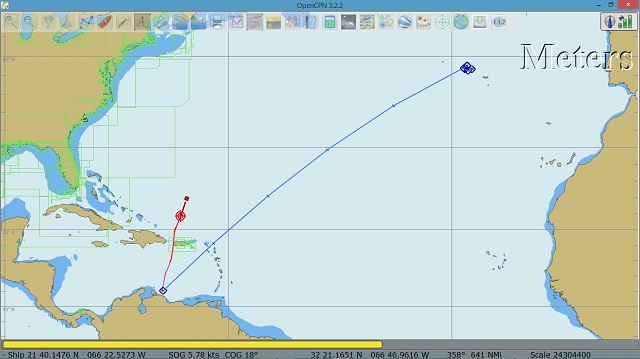
29 May 2014
7:00AM local time (GMT-4). The wind was still easterly 15-18 knots apparent. Sailing with a help of the Raymarine autopilot working in wind-wane mode, 50° to the wind starboard. The total GPS track distance was 614 nm or 135 nm for the last 24 hours or 5.6 knots on average. Partially cloudy. Atmospheric pressure was 757 mm on my barometer or 1009 mb.
I thought the barometer was not showing the correct absolute values because according to the weather charts, it should have been 763 mm or 1018 mb. Got a screwdriver, removed the barometer from the bulkhead and adjusted the arrow by rotating the screw at the back. I was able to set it to 764 mm, oh well, still better than it was.
Weather forecast for the following 72 hours looked good. The wind would finally turn south and south-west. There might be a dead area with no wind but not too large. For tomorrow, I still should expect easterly wind around 10 knots.
After lunch, I took off the last reef on the main and prepared genoa but decided to wait till tomorrow to replace the jib because at night in tropics the wind is usually 3-4 knots stronger than during the day.
A shame to admit that I collected a goody bag only on my fifth day of sailing. It had just kept bugging my mind all the time what if I needed to leave the boat in a hurry. I put their my documents, a bottle of water, EPIRB, 3 flares, a wet suite and a rain coat. Not much indeed. 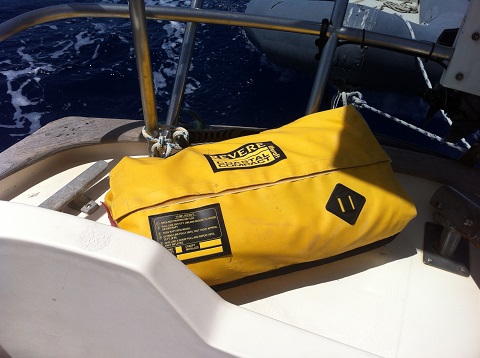 An inflatable liferaft (a small coastal model without a canopy) is ready on the deck and the dinghy is also there at the stern. Ideally I would need to get a pump for the dinghy and a bailer plus more fresh water.
An inflatable liferaft (a small coastal model without a canopy) is ready on the deck and the dinghy is also there at the stern. Ideally I would need to get a pump for the dinghy and a bailer plus more fresh water.
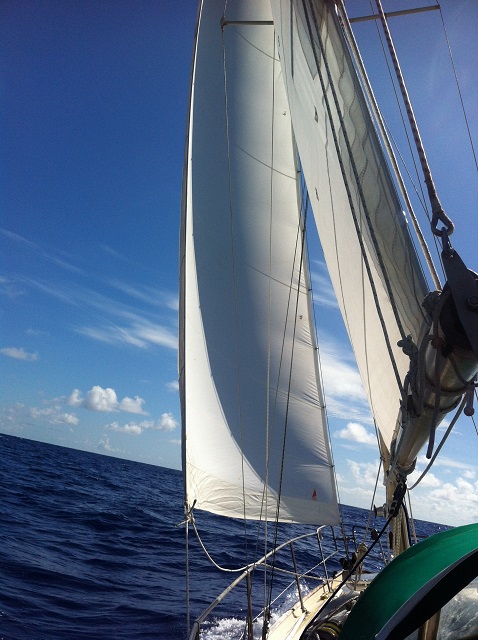
30 May 2014
The autopilot in wind-vane mode woke me up a few times alarming of wind shifts. Damn it and the programmers who invented such a great "safety" feature and not even bothered to add the option in the settings menu to disable these annoying beeps or at least to adjust the maximum angle of a wind shift. They included the absolutely useless option to windsteer to the true wind as opposed to the apparent one. How thoughtful it is indeed! Why on earth at sea one would want to steer to the true wind? Or is it just a Raymarine marketing trick to force folks to buy a remote control? A 15° wind variation triggers the alarm. In a high pressure area where I'm right now the wind is constantly changing and not much I can do about it except that not to use the autopilot. If I set it in a compass mode, then I would need to adjust the sails all the time. Am I too lazy or too old?
Well, since I've already started criticizing Raymarine, I should say that their chartplotter has a bug too. After couple of days it stops displaying the correct date and time despite that the GPS is working ok all the time. The only way to fix it is to restart the chartplotter. Resetting the GPS has no effect. Aren't the marine manufactures supposed to make reliable products that are thoroughly tested before sold on the market?

The breakfast first: muesli with milk and believe it or not, Dominican ground coffee with chocolate wafers, then genoa thing and weather fax at the same time. New Orleans starts transmission of interest at 8AM for about one hour and a half. Today in the middle of the reception I had to switch to a different frequency, 17,144.5 kHz due to a major interference on 12,788 kHz. It worked ok too. Here is the screenshot of JVComm32. You may see the interference. This one I was able to fix by adjusting Twin PBT. In the right upper corner there is a spectrum window. The white signal predominates it and usually is much narrower than shown on the picture. It is easy to distinguish it by listening the audio by high pitch sound and filter it from the noise. You may also see how to listen to the microphone (well, it is rather the linear input). When I plug the audio jack into my laptop the Windows asks if it is headphones or a microphone. It is important to select the microphone. By default, the headphones are checked.
Tropics were left behind but it was still hot in the cabin. I guessed it was summer, wasn't it?
Saw a green flash at  the sunset. Even recorded it but on a video it was not seen very good.
the sunset. Even recorded it but on a video it was not seen very good.
31 May 2014
I hoped that the wind would increase overnight as usual but it did the opposite. I was sailing at 4-8 knots wind at night steering 70° to the wind making 3 to 4 knots and resisting to start the engine. It was so quiet this way. The autopilot was waking me up all night with its "Wind Shi..ts" alarms.
I got up early and recorded the beautiful peaceful  sunrise. Then yoga and cottage cheese with yogurt for breakfast following the cup of coffee with milk.
sunrise. Then yoga and cottage cheese with yogurt for breakfast following the cup of coffee with milk.

At 7:00AM local time (GMT-4) GPS track showed 852 nm and the water log was 906 nm. Beruta is slightly ahead of 120 nm a day after 7 days of sailing.
Here is my position at around 8:30AM local time. The red circle shows the position. The vessel's coordinates, speed and course are displayed at the bottom status bar. The red square shows the estimated position in 24 hours.
I have learned how to use OpenCPN weather fax plugin. The plugin can either receive faxes (I haven't tried it yet) or overlay the images on top of the chart. All I needed to do was to map the latitude and longitude to the image's Y/X coordinates. Here is how it looks.
After lunch (stewed beef with vegetables) spent the energy on cleaning the stanchions, railings and multiple other stainless steel tubings on the stern.
Made a route to Graciosa from the current position. Magnetic course 65°. The distance 2000 nm. The wind became abeam starboard, so I changed the wind-vane mode of the autopilot to a compass one. This will stop the annoying beeping at night!
At 17:25 local time the wind died completely (3 knots). Had to start the engine. Not an easy question where to motor: north or straight to Azores? Theoretically north was better because this should save the fuel but in a forecast a cyclone was passing on the north in the next two days bringing cold front, high pressure and also little wind. Heading to Azores was not good either because at these latitudes (26-28° N) in the forecast the wind was 5 knots of less and mostly dead run, which meant no wind at all. And I'd rather have not used more than a tank of diesel, which was just about two days of motoring. Hm... Steering to Azores for now...
20:05 local time got another weather forecast. At night, the reception was better probably due to better wave propagation and less interference; it had something to do with the solar activity. Here is a list of weather charts that I receive:
- Tropical Surface Analysis (W Half)
- Tropical Surface Analysis (E Half)
- 24 Hour Wind/Wave Forecast
- 48 Hour Wind/Wave Forecast
- 72 Hour Wind/Wave Forecast
- 24 Hour Surface Forecast
- 48 Hour Surface Forecast
- 72 Hour Surface Forecast
- Cyclone Danger Area Or 48 Hour High Wind/Waves
You may see from these charts that if I continued motoring at 65° M to Azores, then soon I'd end up in the area of 1018 mb without any other isobars close to me meaning that Beruta would be out of wind. Therefore, I changed the course to 15° M to north. Tomorrow I should have some wind on a portside.
On the dark skies I saw lightnings behind the horizon, attributes of a warm front.

1 June 2014
I woke up around 4. It was still dark. The wind was broad reach on a portside 4-6 knots. I decided to wait for another hour until dawn and then hoisted the sails and stalled the engine. 12 hours of battery charging! And probably 6 gallons of diesel went. Well, back to sailing!
My morning yoga was interrupted by a couple of showers. I even got cold. Finally I felt like I was no longer in tropics. Thought that a hot oat meal with milk and butter would make me warmer. As a matter of fact, they did as well as the rising sun and a cup of coffee. Continued sailing north keeping the course 10° M, abeam portside at 4-5 knots with the southwest wind 7-10 knots. According to the forecast, the wind was going to change to northwest when the cold front passed.
At 7:10 the total GPS distance was 921 + 47 = 968 nm. Here is my track at 9AM.
At 12:30 the cold front arrived. I should have known better... A cyclone is a cyclone and a front is a front meaning that there will be gusting winds and showers even if they are not shown on the weather charts. I have taken genoa down when the black scary cloud approached and took two reefs on the main. Just in time. There were couple of strong gusts to 30 knots, then the heavy rain started. When it finished, the wind died and I motored for 30-40 minutes. Then the wind picked up and shifted from SW to NW to NE increasing from 20 to 30 knots. This lasted for about 4 hours. Just under the jib Beruta was making over 7 kts. At 17:00 the wind became 10-15 knots and at 19:00 it was switched off. I motored again to the north and waited for the second front to pass. Hopefully it would not be as dramatic as the first one and not come at night.

2 June 2014
I was tired but soon after midnight I woke up because Beruta heeled a bit. Yes, it was 16-20 kts of N wind. It would have been a shame of me to continue wasting the diesel, so I replaced the genoa with the jib, hoisted it (half of the main was already up) and sailed 40° to the wind keeping the course of 45° M. Much better, as at 2100 rpm I was making 4 kts. Under the sails it was 6!
It was the first night when I wore cloth: a shirt, jeans and a rubber rain suite. I felt like I was close to Nova Scotia likely where this cold air was brought from. I even prepared fleece jacket for the next night.
Two things that worry me at the moment. Last time the engine did not start at first when I turned the key. It happened once on Curacao but it had not repeated, so I did not know what to fix. It was like the battery was low: when you turn the ignition key and nothing happens. But it was not the battery for sure. Maybe just the contacts somewhere needed to be cleaned. The second problem was the whistling noise from the airgen. It still worked but who knew for how long.
To Bermuda, it was only 260 nm from where I was at the moment. In a good wind it was no more that two days of sailing but the direction was right where the wind blew from.
At 5:00 had an early breakfast: couscous made with salt, sugar, milk powder and served with butter. Coffee and mocco sticks for the desert. Yeah, looks like the second weaker front passed at night over me. There were just heavy clouds, a bit of rain but no strong gusts.
At 6:40 the total GPS distance was 921 + 158 = 1,079 nm. Here is my track at the same time.
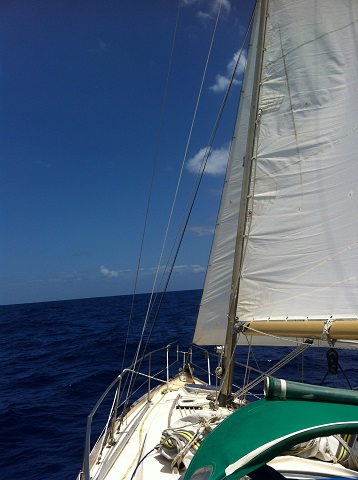
At 10 set the genoa. At first, I was able to windsteer 50° to the wind but then the wind weakened to 6-8 kts and I had to change the angle to 60°. Speed 3-4 kts. Slowly was moving eastward. The northerly wind did not allow me to go above the 30° latitude. Would probably motor overnight to north again as there was not much wind in this area. Anyway, the front passed, look at the clear blue sky!
Here is 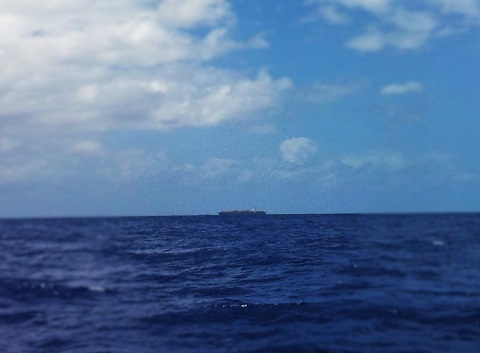 a picture of Buxcliff sailing 3 nm north of Beruta at 19 kts in the opposite direction.
a picture of Buxcliff sailing 3 nm north of Beruta at 19 kts in the opposite direction.
14:00 no wind. Started the engine, going north. After an hour, I ran into some clouds and got some wind but not for a long time. Beruta was able to sail east 10 nm or so. Keep motoring north, then sailing east and so on.
At sunset took a shower, made a salad and another attempt to utilize the wind power. It lasted only for 20 minutes. I started thinking of making a stop on Bermuda. It was two day sailing NNW but mostly against the wind, so primarily motoring. I could get some fresh fruits and vegetables there and fix one or two things; for example, get a superglue and use it for the Raymarine chartplotter joystick button repair. The bike tube rubber glue that I had did not work. I ended up using  the proven duct tape method.
the proven duct tape method.
Around 20:00 the wind picked up again. 15 kts in a clear sky full of stars and the halfmoon. Sailing 60° to the wind, 30° N making 6 kts. See you Bermuda, another time.
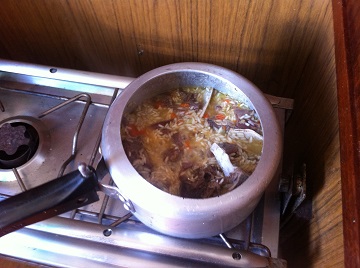
3 June 2014
I slept more or less ok, tried not to pay much attention to "Wind Shifts" messages. At 4:30 I got up because the wind not only changed to broad reach but also increased to 20 kts and under all sails Beruta was flying dangerously. Took the genoa down. Soon the wind became lighter. Hoisted the jib instead. Sailing at 5-6 and occasionally 7 kts to Azores. The course is 65° M. Want to get a little bit more north yet. But not too much because the dissipating low was actually moving my way now. It shouldn't be too bad but there was no need to go into higher wind area north of 32° N.
At 6:40 the total GPS distance was 921 + 270 = 1,191 nm. Here is my track at 8:05.
The problem with downwind sailing is rolling and an autopilot. The first one is annoying and not meal/drink safe. The second one is bad steering: plus/minus 30° off course. A way to fix yawning to some extent is to reduce the sails, i.e. take a reef or two on the main, sail under a foresail or a main alone. Ah, and peeing from a stern does not work, remember that. And the lower the speed, the shorter the dinghy leash has to be to avoid unpleasant tugs on a towing line.
Here is the picture of a la plov, the Caucasian meal made with a lamb, onions, carrots and rise. I had a goat instead and did not use vegetable oil. This was the last meat from a freezer, which became empty and ready for some fish!
4 June 2014
There was almost no wind since yesterday. 4-8 kts. Was running under the main 80° M at 3-4 kts, sometimes less than 2. The NW swell was unpleasant if not to say more. I was tired having not much sleep these days and woke up after the sunrise. Beruta was rolling and not making much of progress. Made my morning gymnastics and was about to have breakfast when I spotted that the main above the spreaders was torn! Damn it! Lowered the sail. Hoisted the genoa to keep sailing downwind.

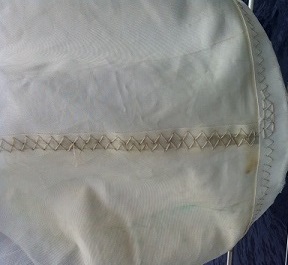
Interesting how this could have happened. The possible reason was the 10-month exposure to the sun in DR. No, actually, I recalled the true reason. Beruta had been chained in Cap Cana marina and the chain went around the boom destroying the uncovered main. Now you know what to think of a competence of Dominican employees working at the marina. When they had arrested me, I could not have put the sail cover. It was good that there was no wind; otherwise, the main could be torn in half. Except the swell and couple of little showers, the weather was perfect for sewing the sails. I stitched the torn seam and also replaced the 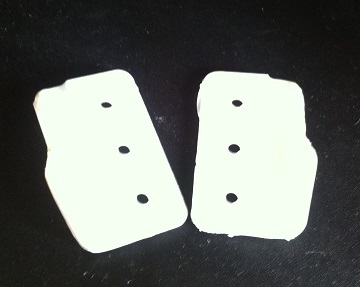 broken line stopper on the leech. I had to take it from the old main. It had
broken line stopper on the leech. I had to take it from the old main. It had 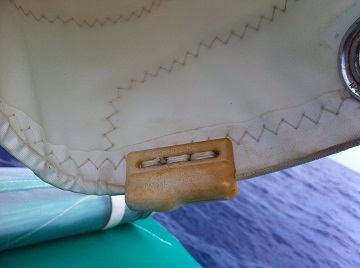 better quality stoppers. At the same time I replaced two wear pads made from the old sail cloth under the reef points around the leech. This was where the blocks were wearing against the leech.
better quality stoppers. At the same time I replaced two wear pads made from the old sail cloth under the reef points around the leech. This was where the blocks were wearing against the leech.
I had finished repairs by the lunch time and there was still no wind. Motoring again straight north. I need to go up at least 2° to get some wind. Here is my track at 16:45 GMT-4.
At sunset, I poured two 5-gallon cans of diesel into the fuel tank. It had always been a messy job to do. I had found the reason why the European cans did not work during previous Transatlantic. A designer, instead of creating a small vent in a canister, made a little hole in the nozzle! Genius! Have they ever proved the concept? I mean have they tried at least once to pour diesel through that nozzle? It will be everywhere and it was not obvious that there was a hole. It looked like a cap had a bad gasket or something because the hole was hidden inside the cap. Never mind vacuum. Before the departure I had used a soldering iron to melt a plastic material of the nozzle and close those holes on all of my 3 cans. Also, I made  an acceptable funnel from two different kinds of funnels: one was high, another wide with a mesh filter. I simply taped them together. Strange that they don't sell something like this in a marine store.
an acceptable funnel from two different kinds of funnels: one was high, another wide with a mesh filter. I simply taped them together. Strange that they don't sell something like this in a marine store.
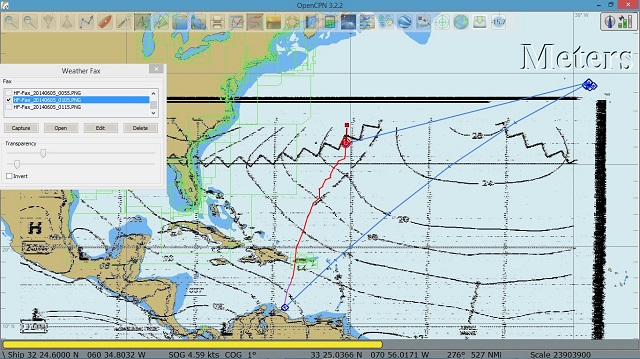
5 June 2014
I passed 32° N at night and still 0 wind despite that the weather chart shows 5-10 kts from the south and would work quite well for me. If you look at the surface analysis chart, then you will see that I was right in the ridge, the area with the least pressure gradient (the largest distance between the isobars). That ridge would move south in the next 24 hours, and I was still motoring north further away from that ridge. So hopefully later today or tomorrow I would have some wind.
By the noon, the wind came, not exactly from the south rather from SE, 10-15 kts. I was able to sail under the main and the genoa 50-60° to the wind on a starboard towards my destination, the Azores, making 5-6 kts. Last engine time was 22.5 hours.
For the lunch today was a tuna soup, the can's fish. The live one was not aware of the vacant room in my freezer.
Around 18:00 the wind became calm again but not for a long time.
6 June 2014
The rain wake me up at midnight. The association was simple: rain meant possible squalls. I got up immediately. It was blowing 16 kts but started gusting to 18. I put on a rain coat and a life jacket with a harness and a tether connected to the starboard jackline and went to the mast to take the reefs on the main. By the time I finished, the wind was already gusting to 20. I changed the genoa with the jib. Soon after I hoisted it the wind further increased to 20-25 gusting to 27. When Beruta is reaching, it does not need more than 15 to fly with a jib and two reefs on the main. I lowered the main. The boat was still making 6 kts. I began thinking that might be 33° N was too north.
At 4:05 I received weather faxes from Boston broadcast station, call sign NMF, at 9108,1 kHz. There was another low pressure area located between 40 and 50° N moving NE. The cold front would pass me tomorrow evening. Hopefully it would be more occluded rather than cold. Indeed, I should not go any more north and would stay at 33° N or even go one degree south to remain in 15-20 kt wind zone. I learned from the previous front that when it was 15 kts on the chart, it would blow 25-30 for about 4 hours. Weather charts are spaced at 24-hour intervals; therefore, these 4-hour variations are not displayed there.
This day, June 6, 2011, three years ago I started my first Atlantic crossing from St. Martin to Flores, Azores. The great circle distance was 2090 nm. Today I was 1400 nm from it. At 7:00 (GMT-4) I was almost half way from Curacao to Graciosa. 921 + 579 = 1500 nm from Curacao and 1550 nm to my destination. It took me 13 days to cover one half of the route. Three years ago it was 11 days for half way but the distance then was 300 nm shorter and there was no dinghy towing. On average, I made 115 nm a day or my average speed was 4.8 kts. Not too bad.

The second half is usually faster because the high pressure area is behind. Last time it was just 8 days compared to 11 for the first half.
There were showers all morning and later afternoon. I guess because the cold front pushed lots of warm moist air ahead of itself. I overlaid the satellite image on the chart and outlined the front by the blue line. I kept sailing along the 33° N east on 110° M course. The south wind was 15-20 kts and the boat speed was over 6 kts reaching on the starboard.
Monica was right. The fresh food that I purchased was enough for two weeks. Well, I could not get more because of the limited space in the fridge. Now back to cans. The first one was beef with potato. Looked good. Tasted also great after I added fresh onion, garlic, dry parsley, oregano and basil.
When the wind started gusting to over 25 kts again, I lowered the main hoping to sail under the jib for the rest of the day and at night and changed the course to 130° M. The weather made fun of me. Soon after the wind died to less than 10 kts. I waited for 15-20 minutes and raised the main again, well, just half of it. The wind picked up again to 15-20 kts and there were couple of more squalls before the sunset.
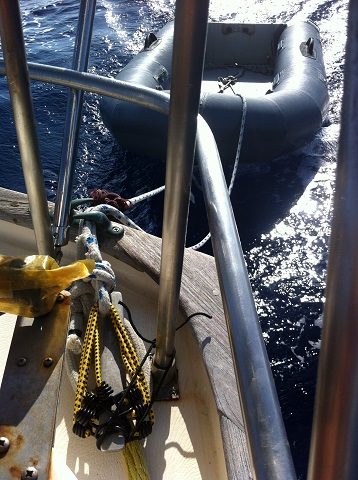
7 June 2014
The night was great though. I sailed close hauled 60° to the 15-20 kt wind on the starboard keeping 130° M course to possibly reach 32° N. The front that I was waited for dissipated but there was another weak low that would create 25-30 kt wind in my area if I continue straight to Azores. I was not in a rush to get there because for the last couple of days there was quite a storm north of the islands with a gale force wind hitting my destination. Hopefully when I arrive there at the end of June, the weather settles and I can cruise those islands that I haven't seen before.
I got up after the sunrise and the clear blue sky told me that the front was gone. The third week of sailing alone in the Atlantic ocean. The GPS showed 921 + 710 = 1,621 nm and the log - 1,718 nm, over 100 miles more. A few days last week I was struggling the 0.5-1 kt current. Here is my track and the weather for tomorrow at 15:45 UTC. I changed my clock to UTC yesterday since the summer in Azores is the same and all weather broadcasts are given in UTC as well. Also, on my latitude at 8:00 is a dawn and at 24:00 is a dusk.
Today for lunch I made Russian vinegret, a salad from boiled potato, carrots and bits with pickles, fresh onion, resin, dry parsley and olive oil. For the main meal I opened a classic chicken noodle soup can.
After I received the weather forecast at 19:05 UTC, I changed the course to 100° N. Decided that half degree was enough moving south. The wind was around 10 kts in the evening, broad reaching on the starboard.
The dinghy at the stern requires some attention when sailing downwind. The following waves move it forward and when Beruta accelerates going down from a wave, there is a strong shock on the towing line. It began wearing in some areas and I had to improvise and made a shock absorber from five stretch cords (see the picture).
8 June 2014
I slept almost 12 hours. Well, I heard what was going on around Beruta and felt it but did not get up and look. My body needed that rest. It was right to use the stable weather and wind to take the opportunity for it.
I got up around noon. Beruta was broad reaching under half main and the jib at 5-6 kts with SW 10-15 kt wind on the course 100° M. The GPS showed 921 + 837 = 1,758 nm at 12:08 UTC. Here is my track at 20:28 UTC and the weather for tomorrow. As you may see, the gale was just 2 degrees north of Beruta. I should not go any further north for the next day or two. At 21:30 UTC I even changed the course to 120° M to be on a safe side. June 10 the front should pass me and the wind would become northerly. The front does not look too bad on the satellite image. I highlighted it with the solid green line.

For the lunch I made a tuna salad from tomato, green pepper, salad, resin, oregano, ground black pepper and olive oil. For the supper there were fried eggs with onion, cheese and  red wine.
red wine.
Reading a Russian novel by K. S. Bagidin "The wreck" about the Amber Chamber treasures taken by Nazis as a trophy from Moscow during the World War II and hidden in Kaliningrad, the former Kenigsberg. Prior to it, I finished the first volume of Victor Konetsky's sea stories "Underwater Rocks".
The sargasso weeds finished some time ago. For the last few days I saw Portuguese man-of-wars. Only birds were around me most of the time. Today was my first attempt to catch some fish after Puerto Rico. No luck.
After sunset there were three little squalls with some rain. The wind seemed to blow steady 20 kts. I lowered the main and sailed under the jib overnight. Yes, I lost maybe 1.5 kt but I slept good without worries.
9 June 2014
I raised the main again, well, just the half of it, around 11:00 UTC. Back to 6.5 kt. At 12:20 the GPS distance was 921 + 967 = 1, 888 nm. The weather was good: sunny with few clouds.
Today I made a Moldavian (or Turkish, or Romanian) dish from fried onion, egg-plant and tomato with fresh garlic, served with boiled potato and butter. Hmm, yamy! Red wine, George Shearing at the foreground and the sea sounds at the back. The paradise!
The weather does not look good for the next few days, little wind in wrong direction. The distance to Graciosa is 1,180 nm. Here is my track at 20:45 UTC and the weather for tomorrow.
In the evening the wind weakened to 10 kts. It looked like the front would pass Beruta at night. The sky had dark heavy clouds on the NW horizon. The atmospheric pressure further dropped by 2 mm.

I prepared to meet the weather and was waiting for the clouds. They moved slowly and more or less parallel to my course approaching from time to time and then again moving away. The moon lightened the ocean and then disappeared. It lasted for 2-3 hours. Then the wind changed to NW. I lowered the jib because Beruta was running and it was no use for it and gybed to the port. The wind was 10-15 kts but not for a long time. The beginning of a heavy rain killed the wind. I waited for some time and then decided to motor. The engine did not start. This time I was turning the ignition key perhaps 10 times or more and suddenly it worked. Hm... This worried me again.
10 June 2014
I was motoring till noon UTC for 7 hours when the wind kicked up again, initially 10 kts and then 15. I took off the reefs on the main and raised the jib. When it began gusting to 18, one reef helped the autopilot with a weather helm. Beruta was close hauled, 50-60° to the wind making 6.5 kts on the 105° M course. I thought to reach 40° W longitude before taking a course straight to Graciosa. If I did it now, I was risking to get in a way of a cyclone. The last two of them had used this route.
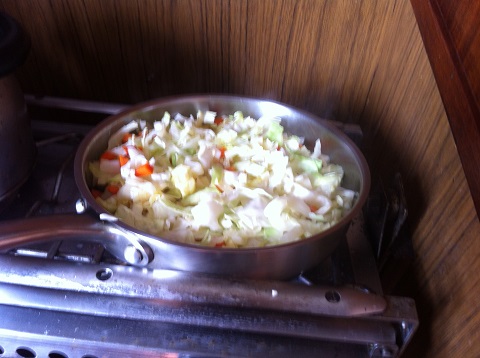
The first thing I did after I had stalled the engine was just that: I started it 3 times and it did without a problem. The second thing was I read the Yanmar service manual. Well, in the troubleshooting section it said mostly about a poor contact somewhere. I tended to agree but the fact was that when the key is turned, the voltage dropped because the lights on the panel dimmed or actually switched off. This told me that the pinion was engaged to the fly wheel by the magnet and the voltage was on the starter's motor but it did not turn! I have a home and engine battery combiner switch, which has a built-in protection for sensitive electronic equipment on board. It disconnects the power, when it detects an attempt to start the engine. I think it does it by measuring the voltage drop. That is why the lights were off rather than dimmed. Actually, no. The engine control panel is powered from the starter cable, which bypasses the combiner switch. I didn't really know what to do about this starter problem. It was located on the port side of the engine and there was no space in that part of the engine room to inspect it, especially at sea.
At 12:00 UTC the GPS track distance was 921 + 1007 + 72 = 2,000 nm! The log showed 2,090 nm. The reason I use the formula for the GPS distance is because each track on a Raymarine chartplotter is limited to 3,000 points. When it reaches the limit, it starts a new track. I should have downgraded the precision from medium to low, then one track would have covered more distance. Yesterday it started the third track, so I had to sum three figures. The Raymarine log does the similar thing. Its display is limited to three digits, so after it gets to 999 it starts over again. Now it is on its third round.
I set the autopilot to windsteer 50° to the wind because the wind was shifting all the time. Here is my track at 15:50 UTC and the weather for tomorrow.
For the dinner there was stewed vegetables (onion, carrot, cabbage) with canned beef and a fresh garlic.

The wind became less than 5 kts at 20:00 UTC and from ENE, right where I needed to go. The latest forecast for tomorrow basically had no wind in the anticipation of another cyclone next day with a gale force wind north of 35° N latitude. The front would pass me on the 13th of June, I believed, and then there would be little northerly wind or no wind at all. Anyway, I started the engine at 20:30 without a problem. At 21:00 added 10 gallons of diesel to the tank. It looked like I had to motor for at least 24 hours or more.
At 22:00 UTC I was able to sail again under the genoa and full main 55° to the wind moving approximately 90° M making 5 kts or so with 8 to 12 kt NNE wind.
11 June 2014
I had been thinking of the engine problem these days. Perhaps, it was a poor contact somewhere. It seemed like when the voltage was higher than usual, it started but when it was normal, it did not. Basically, the voltage dropped on that poor contact and from the starter point of view it looked like the low battery situation.
After my morning yoga and a breakfast, I inspected the engine wiring. The starter power cable and terminal looked ok. The negative wiring was good. The control panel connections were also clean. There were no signs of corrosion there. Then I recalled one connection that goes to the starter's magnet. During repowering Beruta (replacing old Volvo with new Yanmar in US), we had had hard time trying to connect that wire to its terminal. Chris from Niemec Marine finally did it but I had always been worried about this connection. When I touched it today, it fell off. That was probably the case. I had to remove the alternator, so that I could get into that tight space with my hand. I crimped the terminal to make it firmly fit the other end. The other terminal seemed to be bent. When I tried to get there with pliers to straighten it, I shorted the starter cable. There was a distinctive sound and lots of sparks. Damn it! If I blew out the 300A breaker, then it would have taken me another job to replace it. I hoped that I had a spare. But I was lucky, when I finished putting back the alternator and tightened both belts (I had done it before my departure, but they became loose again), the engine started without a problem.
At 12:30 UTC GPS showed 921 + 1007 + 190 = 2,118 nm. The log - 2,214 nm. This morning I was making 2-3 kts through the water under the sails with the NNE 4-8 kt wind plus almost a knot gave me the current.
At 13:00 UTC there was 1,000 nm to Graciosa. At 13:30 I had to use the engine. There was 0 wind for the rest of the day.

I was reading Jacques-Yves Cousteau "The Silent World" about his experiments with the first scuba diving equipment.
Fried eggs with onion and cheese that you see on the picture were for my supper today. Last eggs and cheese by the way.
Here is my track at 22:30 UTC and the weather for tomorrow.
12 June 2014
I stopped the engine at 11:10 UTC. It had been working for 22 hours. The wind was 5-10 kts right into the stern, 5-10 kts less than in the forecast.  Beruta was running under the full main at 3.5-4 kts on its course 78° M to Graciosa. 885 nm left to my destination.
Beruta was running under the full main at 3.5-4 kts on its course 78° M to Graciosa. 885 nm left to my destination.
This morning I opened the last bag of cereal and the last 1-litre pack of milk. My menu for the next three days would be Russian borsh, the bits and cabbage soup with potato and pickles and the canned fish soup. This would be for lunch. As for the breakfast there would be hot cereal for the rest of the voyage. I ate the last apple today. In terms of the vitamins there were 4 oranges left in the fridge and 4 liters of Ceres natural juices. Besides hot cereal, it would be just can's food with noodles or rice. Cookies for tea or coffee also almost finished.
The reason I tell you about food a lot is because there is not much entertainment during solo navigation in the Atlantic ocean. The meal is the only pleasure your body could have on board of a vessel when sailing single-handed, besides the nature of course. But the ocean, the skies, the stars and the moon, sunsets and sunrises, and birds are mostly for the soul. The reading serves the same purpose.

Borsh it was with mussels and last avocado as appetizers. I've always remembered my children when we had been waiting for the mom in the Edmonton's parks in Canada and ate mussels with crackers. Edik ate his fruit tofu. I had asked Jan (he is on the right picture rowing with me in the Ob' sea during our fishing in village Antonovo near Altai region in Russia) and 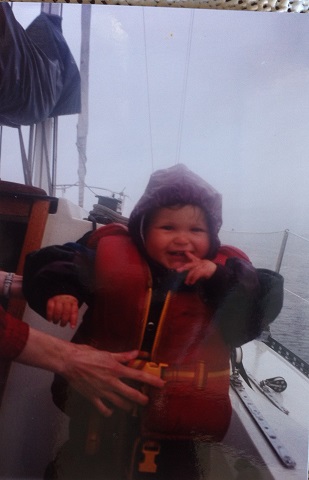 Edik (sailing in Vancouver) to go with me on this trip as I had done on my first Atlantic crossing. Jan said that he promised a road trip to his friend and I didn't even bother to ask Edik's mom because I knew she would have been against it. I understood Jan. At 21 who would want to spend a summer break with parents rather than friends?
Edik (sailing in Vancouver) to go with me on this trip as I had done on my first Atlantic crossing. Jan said that he promised a road trip to his friend and I didn't even bother to ask Edik's mom because I knew she would have been against it. I understood Jan. At 21 who would want to spend a summer break with parents rather than friends?
When I was 14, the Edik's age, three of us went down the river Dnepr in Russia from Smolensk to Mogilev in Belorussia on a sailing catamaran made from two canoe hulls. Next year, we sailed one of the greatest Siberian rivers Ob' from Novosibirsk down to New Port, which was north of Arctic Circle, and then from Arkhangelsk in White Sea to St. Petersburg on a 6-meter Russian-designed and built sailboat Assol'. I would have given everything for the opportunity to cross the Atlantic those days.
Each generation is different. Why would a son of a chess trainer become a sailor? A son of a sailor may become a good poet or an artist. My children don't have to share my dreams. Indeed, they would have their own ones, valuable only to them.
It is quite natural to start counting days when the provision especially beverages, go to the end. Tomorrow would be the end of the third week of my voyage. I estimated that I would need another six days to arrive to Graciosa. I thought Thursday or Friday next week (June 19 or 20) I would be there.
The cold front approached as usual in the evening. The wind shifted to the north right before leaden heavy clouds were above the mast of Beruta. I took two reefs on the main, just in case there would be a squall. When it became clear that the clouds were only scary but innocent, I hoisted the jib. Beruta was making over 6 kts reaching on its course of 78° M 90° to the wind on the portside. Among three fronts that had passed Beruta to date, this one was the best: no squalls and almost no rain, plus the favorable wind. I slept good.

13 June 2014
My mom's birthday. She would have been 67 today. She never knew that my dream to sail the world became true. When I was young, she supported me in all my adventures eventually after being against them at the beginning. I'm very grateful to her for this courage.
At 12:00 UTC the GPS distance was 921 + 1,007 + 440 = 2,368 nm. The log showed 2,465 nm. Here is my track at 13:30 UTC and the weather for tomorrow.
I had expected a clear skies and good weather today but instead it was cloudy and rainy with little squalls. Was I too quick saying good words about the front yesterday? Or was it the northerly wind that brought the bad weather? The atmospheric pressure was high and rising though.
In the evening finally came the dolphins! The first time during this voyage. I had been afraid that the black color of the bottom might have been frightening for them. I recorded how they were playing with Beruta on my iPhone. Unfortunately I forgot to download and install any video editing software before the trip. I would have to do it later and then I would post the video here.
14 June 2014
Today was the beginning of the fourth week I had been at sea. As I had said before, my longest voyage so far was 21 days during the second Atlantic crossing.
At 12:10 UTC the GPS distance was 921 + 1,007 + 558 = 2,486 nm. The log showed 2,597 nm.
The 24-hour weather forecast from Boston became of little use as I had passed the 40° W longitude, its eastern boundary on the map. Now only 48 and 96-hour weather forecasts were of interest. I received them in the morning and in the evening, which gave me weather reports spaced at 12 hours. The 96-hour forecast was given only in the evening though.
Here is my track at 20:25 UTC and the weather for tomorrow. Less than 600 miles was left to Graciosa. Another 5 days and I would be there.

15 June 2014
The night was not very quiet. I woke up a few times because the wind shifted, or died, or increased. Around 7:00 UTC in a clear sky it started gusting to 20 kts. I had to change the genoa for the jib but after an hour or so, it became 10 kts again. The exercises with the foresail on the foredeck substituted my morning yoga today. Overnight the wind changed to the north from NNW. I was sailing 60° to the wind on the portside. The course was 80° M. The speed 5-6 kts.

Today was really delicious. From the last bits I made another popular in Russia salad with fresh garlic, dried plumbs, walnuts and mayonnaise. You may also add green pears for the decoration. The main dish was canned salmon soup with the last potato, onion, ground pepper and of course 100 grams of Stoli. The toasts were to the success of the voyage, to my children Jan, Edik and Yana and to my dad. I wished them be healthy and happy.
At 12:00 UTC the GPS distance was 921 + 1,007 + 680 = 2,608 nm. The log showed 2,719 nm. I did not remember if I wrote about it in English but the Raymarine speed meter also had a bug. From time to time it showed an incredible speed; for example, almost 100 kts, then it would drop gradually to the real numbers. That might also be the reason that the in-water miles were higher than GPS ones.
Afternoon the wind was from the north but weak and variable. I played with the sails for a couple of hours, then by the sunset I set the autopilot to do the job for me, I meant windsteer to 50° to the wind. It did not work very well, The autopilot was running like crazy but was not able to follow the wind. At 23:30 UTC I started the wind amplifier and stabilizer - the engine (again after I turned the key several times, damn it!). At 1,800 rpm it created the apparent wind strong enough for Beruta to move under full sails at 6 kts.
16 June 2014
I stalled the engine at 7:00 UTC. The wind was more or less the same but I had only 25 gallons of diesel left. This would be enough just for 40 hours. I decided to move slowly under sails making 2-4 kts with 4-8 kt wind.

After the yoga and breakfast, I checked the engine panel with a voltage meter. The ignition switch was not faulty. I disconnected the 3-wire plug that led to the panel. It had the red positive wire, the blue glow plugs wire and the white starter magnet wire. When I shortened the white and the red, the engine started. The terminals seemed to be ok. I cleaned them just in case, reconnected, then the engine started by turning the key as well. Hm... Still not certain that I found the problem. At least I eliminated the ignition key suspicion. I also found from the service manual the ignition key diagram illustrating that in "Start" position only the magnet and the glow plugs were powered, the lights on the panel were not.
At 12:00 UTC the GPS distance was 921 + 1,007 + 793 = 2,721 nm. The log showed 2,828 nm. The atmospheric pressure reached 772 mm (1029 mb). Because I could only adjust the barometer by 1 mm more than the real pressure was, it should be 771 mm or 1027 mb, which corresponded to the highest number on the surface analysis chart. This was exactly where the Beruta was today. Hence, no or very little wind. I was in the middle of two cyclones: one was north-west of me, another - north-east.
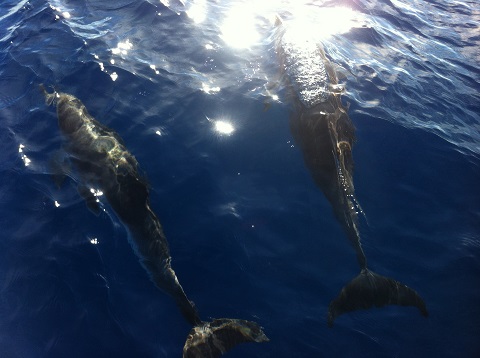
Here is my track at 15:00 UTC.
I used a calm weather to cut my hair and shave. There were no more beard and mustache that you saw on the photo.
At 18:30 UTC the wind was switched off completely. I started the engine (without a problem this time) and changed the course to Horta on Faial island (89° M). It seemed to be the closest place (340 nm, about 50 miles shorter than Graciosa) where I could get good provision, diesel and clear in. That town was the famous among sailors all the time. I had visited it in my first Atlantic crossing. There had been a big marina and a protected anchorage. There had been free WiFi from the marina. The marina had charged me for the anchorage last time 24 euro (8 euro a day I thought). The diesel had been 1.22 euro three years ago, cheaper than anywhere in Europe at that time. Then I could continue to Sao Jorge first followed by Graciosa, Terceira, Sao Miguel and Santa Maria. It appeared to be logical to cruise the islands in this order on the way to Mediterranean sea.
According to the latest 48-hour weather forecast, tomorrow I would have 15 kt following SW wind.
To avoid correcting the course every time the current changed, I engaged the autopilot to steer the route rather than the compass bearing. In this mode, it went from one waypoint to another. I needed to make sure that the first waypoint of a route was ahead of the vessel; otherwise, it would go back to it rather than to the next waypoint. That's why it was called SmartPilot!
17 June 2014
Zero wind. Kept motoring. The morning weather forecast said that might be tomorrow night there would be some wind. I could only use the engine till midnight. Then I had to wait for the wind and leave 5 gallons of diesel for docking, anchoring, etc.
The dolphins started coming every day. This morning there were lots of them. I filmed them. Later I upload the movie here.
For the breakfast was quinoa hot cereal and coffee with cookies.

For the first time in the Atlantic I played chess with Fritz. My Elo 1,450 (Ambitious Club Player) and his 1,700. I resigned. Fritz had 2 pawns at the end. Here is the game with some postgame analysis using the Deep Fritz 14 x64 engine.
1.e4 g6 2.c3 d6 3.d3 Nc6 4.Na3 Nf6 5.Nc2 Bd7 6.Nf3 e5 7.g3 Bg4 8.Bg2 d5 9.Bg5? [9.h3 Bc8 10.exd5 Nxd5 11.0-0 Bg7 12.d4 0-0 13.dxe5 Nb6 14.Bf4 Qxd1 15.Raxd1 Na4+-] 9...dxe4 10.Bxf6 Qxf6 11.dxe4 Rd8 12.Qe2 Bd6 13.0-0 0-0 14.Ne3 Be6 15.Nd2 [15.Nd5 Bxd5 16.exd5 Nb8 17.Rae1 Qe7 18.Qd2 c6=] 15...Qg5 16.Ndc4 Bc5 17.b4 [17.Nd5 Bd6 18.Rad1 Bxd5 19.Rxd5 Qf6 20.Rfd1 Qe6 21.Qd2 a6 22.a4 Rfe8 23.b4 Bf8 24.Bf1 Qf6 25.Ne3 Rd6 26.Rxd6 Qxd6 27.Qe2 Qe7 28.Nd5 Qd8 29.b5 Nb8 30.Nb4 Qf6 31.bxa6 Bxb4 32.Qb5 c6 33.Qxb4 bxa6 34.Bc4 Kg7 35.Qb7 Qf3 36.Rd3 Qf6 37.Kg2 Qe7 38.Bxa6 h5 39.Qxe7 Rxe7 40.Bc8 Re8 41.Bh3 Na6 42.Rd6 Nc5 43.Rxc6 Nxa4 44.Rc7 Kf6 45.Bc8 Re7 46.Rc4 Ra7+-] 17...Bxe3 18.Nxe3 Ne7 19.f4? [19.Qb5 b6 20.Rad1 h5 21.a4 Kg7 22.h4 Qf6 23.a5 c6 24.Qa6 Nc8 25.Qb7 Bb3 26.Rxd8 Rxd8 27.a6 b5 28.Bh3 Nd6 29.Qxc6 Nc4 30.Qxb5 Nd2 31.Qc5 Nxf1 32.Bxf1 Rd2 33.Ng2 Rd7=] 19...exf4 20.Rxf4? [20.gxf4! Qh6 21.Rad1 c6 22.Qf2 Nc8 23.f5 gxf5 24.Nxf5 Bxf5 25.Rxd8 Rxd8 26.Qxf5 Qg6 27.Qf4 Ne7 28.Kh1 Qe6 29.Bh3 Ng6 30.Bxe6 Nxf4 31.Bxf7+ Kxf7 32.Rxf4+ Kg6=] 20...Kh8 21.Ng4 Nc6 22.e5 [22.Nf6 Ne5 23.Qe3 Rd3 24.Qc5 Rc8 25.Qxa7 Rxc3 26.Nd5 Rc2 27.Qd4 Kg8 28.Nf6+ Kg7 29.a4 c5 30.bxc5 R2xc5 31.Raf1 Rc2 32.R4f2 Rxf2 33.Qxf2 Nd3 34.Qd4 Qc5 35.Ne8+ Kf8 36.Qxc5+ Nxc5 37.Nd6 Ra8 38.e5 Rxa4 39.Nxb7 Nxb7 40.Bxb7 Ke7 41.Bf3 Ra3 42.Kf2 Ra2+ 43.Kg1 h5 44.Re1-/+] 22...Bxg4 23.Rxg4 Qxe5 24.Qxe5+? [24.Qe1 Rd3 25.Bxc6 Re3 26.Qd2 bxc6 27.Rc4 Kg8 28.Rc5 Qe6 29.Rxc6 Rxg3+ 30.hxg3 Qxc6 31.Re1 Re8 32.Rxe8+ Qxe8-/+] 24...Nxe5 25.Rf4 b6 26.Be4 [26.b5 Rd2 27.Ra4 Rc2 28.Re1 f6 29.Rf1 Rxc3 30.Rd1 Kg7 31.Rxa7 Rf7 32.a4 Rc5 33.Ra8 Rf8 34.Ra7 Kh8 35.h3 Rc2 36.Be4 Rc3 37.g4 Rb8 38.Bg2 Rc5 39.Rd2 Kg8 40.Kh2 Re8 41.Rf2 Rf8 42.Bf1 Rf7 43.a5 bxa5 44.Rxa5 Nd7 45.Raa2 Re7 46.Rfc2 Kf7 47.Rxc5 Nxc5 48.Bc4+ Kf8 49.Ra8+ Re8 50.Ra7 Rc8 51.b6 Ke7 52.h4 g5 53.Bd5 Kd6 54.b7 Rb8 55.Ra8 Nd7 56.Be4 c6 57.Rxb8 Nxb8 58.Bxh7 gxh4 59.Kh3 Kc7 60.Kxh4 Kxb7 61.Kh5 Kc7 62.Bc2 Kd6 63.Kg6 Ke7 64.g5 Nd7 65.Ba4 fxg5 66.Bxc6 g4 67.Kg5=] 26...Rd6 27.Raf1 f6 28.R1f2 h6 29.Kg2 c6 30.a3 g5 31.Rf5 Re6 32.Re2 Nc4 33.Rff2 Nxa3 34.Ra2 Rxe4 35.Rxa3 Rc4 36.Rf3 Rf7 37.Rd3 Re4 38.Kf3 Rfe7 39.h3 h5 40.g4 c5 41.bxc5 bxc5 42.gxh5 Rh4 43.Rd5 c4 44.Rf5 Kg7 45.Ra6 Rxh5 46.Raxf6 Rxh3+ 47.Kg4 Rxc3 48.Kxg5 Rg3+ 49.Kf4 Rh3 50.Kg5 c3 51.Rg6+ Kh8 52.Rf8+ Kh7 53.Kf6 Rc7 54.Rfg8 Rc6+ 55.Kf7 Rxg6 56.Rxg6 Rf3+ 0-1
So far my statistics with Fritz was 87/197 (-23) = 44%. 80 wins, 103 losses and 14 draws.

At 18:30 UTC I checked the fuel level. 17 gallons left out of 25. 8 were used within 24 hours, less than 0.4g/h. I could run the engine for another 24 hours then if needed. I was motoring first at 1,800 rpm for 12 hours and then another 12 hours at 2,000 rpm. I would check the level again tomorrow morning.
Black clouds were coming from the west, but they did not bring the wind, only the rain. It was the edge of the warm front touching Beruta this evening. The surface analysis showed that I was still in the center of high pressure area.
In the evening I stepped out to the cockpit to check the finishing gear and oh, my god! Whales! Huge massive bodies with high dorsal fin right behind my stern where the pink calamari bait and the hook were. First, I thought... no, they were not fish! They were mammals with much higher intellect than fish. Orcas, the killer-whales, were swimming with the fishing gear, probably just making fun of me pretending that I caught them on the hook. I grabbed iPhone and began filming to only realize that this stupid thing was not recording when the whales had already moved away. Damn it! They were swimming NE slightly north of me. I saw the fins and fountains of water for quite a while on the horizon. On the photo you can see two of them, but there were many.
18 June 2014
Around midnight there was light easterly wind dead to the stern 6-11 kts. I waited. At 3:30 UTC it became SE 12 kts, almost abeam Beruta. Hoisted half of the main and the genoa. Stalled the engine. The tank should have at least 12 gallons of diesel left.
By the dawn the wind shifted to the east again and around 8:00 it changed to NE. Beruta gybed on her own. I only had the main hoisted at the that time. The boom brake worked perfectly. The boom survived. My neck too. The head breaker missed it because I was busy with the dinghy at the stern out of reach of this heavy aluminum pipe. The towline worn, and I was attaching the stretch cords to the spare line. Hopefully, it would last till tomorrow.
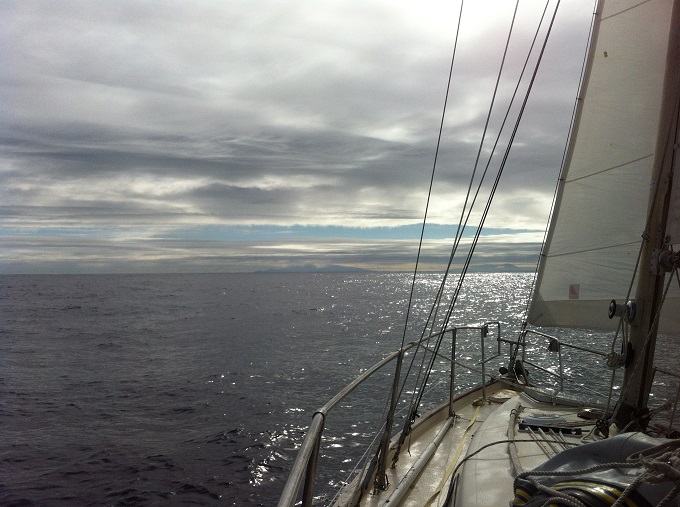
Now Beruta was broad reaching on the portside under the genoa and half of the main making 5-6 kts with 10-15 kt NE wind. It was cloudy with a rain going on and off. Here was my position at 11:00 UTC. 142 nm was left to Faial. Tomorrow afternoon I should be there. At 12:00 UTC GPS distance was 2,950 nm and the log showed 3,070.
Interesting findings there were on the deck this morning: a small squid and the tail half of a small fish. The former had no wings as opposed to a flying fish that usually landed on the deck at night. Was it brought to the deck by a wave? The later was probably a sea bird dropping. Food sharing, wasn't it? Thank you, my heavenly friend!
At 18:00 UTC the front passed and the wind ended. I checked the fuel level. I had 13 gallons. I could use 9 without a special hose that goes to the bottom of the tank. I still hoped that there would be some wind from the north around at least 10 kts near the islands. I saw it on the weather charts. By tomorrow morning I might be sailing again. It was hard to believe that just 2 degrees south of the roaring forties there could be this calm!
I started the engine - the same problem! Hm... I needed to take the starter out and have a closer look at it. There could be a number of problems there but it was very difficult to access it especially at sea. Hopefully, it would start for the anchoring in Horta and there I would investigate further. Because when I turned the ignition key on, I did not hear any click of the pinion getting engaged with the fly wheel, I suspected that the pinion might be rusty or dirty and did not mesh or it could be the problem with a solenoid. There was also no substantial voltage drop, which would indicate that the solenoid connected the battery to the motor; otherwise, the isolation switch would detect it and disconnect the electronics. Usually this meant that the chartplotter would restart.
At 19:15 UTC I still had 105 miles to Horta meaning that I would arrive to the anchorage around 5PM and the marina would be already closed. Therefore, I would need to check-in next day.
Finished reading "True Sea Stories" by Severov P.F. about first Russian sailors who opened many lands and islands.
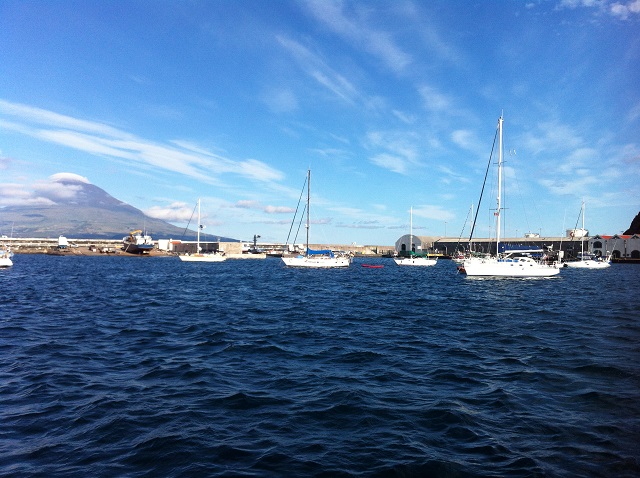
19 June 2014
There was no wind all night. In the morning there was very light northerly wind. I hoisted all the sails and with the help of the engine at 1,800 rpm, the anemometer showed 6-8 kts apparent wind 60° to my course. Then the wind shifted and blew to the nose. I had to windsteer 40° to the wind for some time until the wind came back to the same direction. Motorsailing, I was able to make 5 kts, sometimes more when the wind increased.
On the horizon I clearly saw two islands and shouted mimicking ancient sailors "The land!" The islands were Faial and Pico.
The breakfast and coffee first. Well, after the yoga of course. Second, I measured the level of fuel in the tank. 8 gallons. I could only use 3 or 4 of them without dropping an auxiliary hose to the bottom of the tank. The time was 9:00 UTC. 40 nm left. Roughly 8 hours. At 1,800 rpm I would need about 3 gallons. Hm... I might be ok.
Prepared yellow Q flag to hoist under the starboard spreader and the Canadian one at the stern. Then cleaned the railings and other stainless tubing at the stern. I would shave tomorrow. Today I might just stay on board at the anchor to avoid problems stepping on land without clearing first.
At 12:00 UTC the GPS distance was 921 + 1,007 + 1,090 + 46 = 3,064 nm. Yes, I had started the fourth track last night. The log showed 3,192. 24 nm left to Horta. Thus, the total distance over land would be 3,088 nm covered in 26 days and 6 hours. It would make 118 nm a day or 4.9 kt on average. Good enough! Here is the track at 12:00 UTC.
At 13:30 UTC I noticed that I was reaching over 6 kts. Stalled the engine and was sailing 5 to 6 kts almost abeam (70-80°) with 8-12 kt wind.
When I came to the island, the wind died and then blew to the nose 20-25 kts. I was motorsailing the rest 5 miles under half of the main. 5 gallons of diesel left when I dropped the anchor in Horta around 17:00 UTC.
The marina was full. Sailboats were docked side by side 3 hulls in a row. A few boats were also on the anchorage, but I was able to find a space here.
Around 18:30 UTC I got on the dinghy to the office of the marina and checked-in without a problem in 5 minutes or so. The immigration officer stamped my passport for 3 months and said that if I need more time, I could extend it later.
I went for a walk along the quay. Gradually my memory came back and I started recalling the places I had visited here 3 years ago.
It was late and most shops were closed and the streets were empty. Beautiful and quiet. I was happy. Another voyage was completed, another accomplishment, another reason to make plans and dreams of future adventures.

21 June 2014. Biking to Morro de Castelo Branco
It was Saturday afternoon. I finally figured out what was wrong with the starter - the starter relay! It was shown on the electrical diagram but was depicted in a way that looked like it was integrated into the starter. In the fact, it was separate - 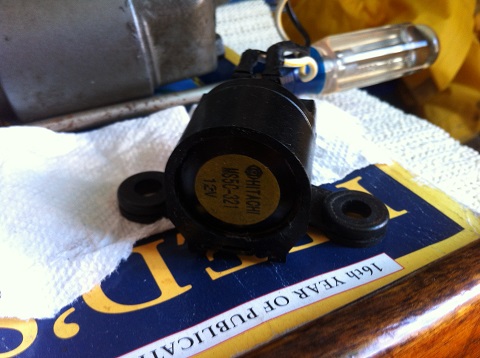 Hitachi MS5C-321 12V relay. First, I had to remove
Hitachi MS5C-321 12V relay. First, I had to remove 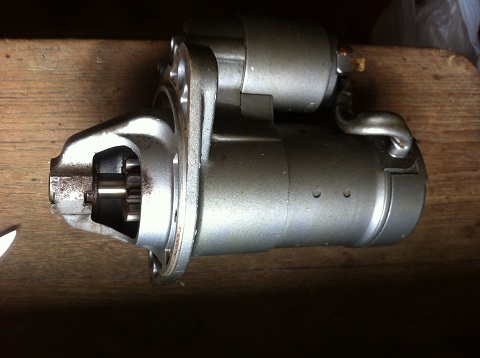 the starter. I connected it to the 12V and tested the pinion and the motor relay. They both worked without a problem. I thought that I asked the Midatlantic Yacht Services if they had it or could order it from Yanmar. If not, then they could suggest the car dealer shop where I could buy any 12V starter relay. I went on a bike but after 13:00 they were closed and all other shops were closed on Saturday anyway.
the starter. I connected it to the 12V and tested the pinion and the motor relay. They both worked without a problem. I thought that I asked the Midatlantic Yacht Services if they had it or could order it from Yanmar. If not, then they could suggest the car dealer shop where I could buy any 12V starter relay. I went on a bike but after 13:00 they were closed and all other shops were closed on Saturday anyway.
Therefore, I had nothing to do till next week and went on exploring the island. I started biking clockwise on EN1-1A towards the hospital. There was the hypermarket Continente prior to the hospital. It was open till 9PM. I had time. So I carried on the same road until I got to the Morro de Castelo Branco Natural Park. 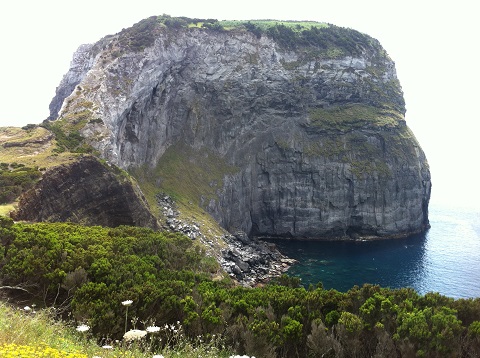 From the distance it seemed to be impossible to climb the peninsular but when I got closer the path to the top was clearly seen. I hid the bike in the bushes and stepped on it. A few minutes later I was
From the distance it seemed to be impossible to climb the peninsular but when I got closer the path to the top was clearly seen. I hid the bike in the bushes and stepped on it. A few minutes later I was 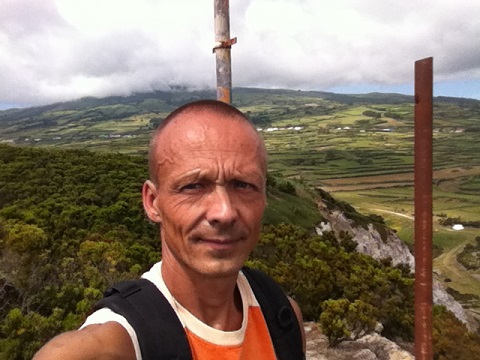 at the top. The trail went in
at the top. The trail went in  the small tree jungle. I saw many flowers like
the small tree jungle. I saw many flowers like  this one. At
this one. At 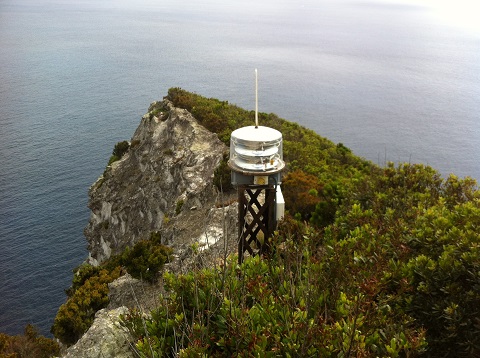 the navigation light a la a modern light house, the path ended. Just to the right of it I discovered
the navigation light a la a modern light house, the path ended. Just to the right of it I discovered  old ruins. From there the path went down. I followed it for a while but then realized that it would go all the way down to the sea. I was in a hurry to get to the supermarket before it closed, so I turned back. Here is
old ruins. From there the path went down. I followed it for a while but then realized that it would go all the way down to the sea. I was in a hurry to get to the supermarket before it closed, so I turned back. Here is  my track.
my track.
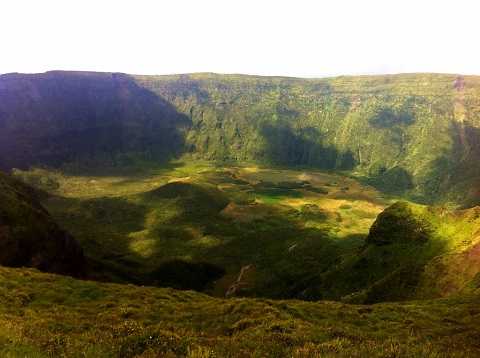
22 June 2014. Biking to Caldeira volcano crater
Sunday morning I put back the starter and wiring. The only thing that was left to replace the relay, which I needed to buy Monday. Afternoon was free and after the lunch, I jumped on the bike and off I went. I thought that I was going around the island counterclockwise but later I turned towards the center of the island where the crater of the old volcano Caldeira was located.
The road was constantly going up. I used the second, the third or the fourth gear of my ATV mountain bike out of 9. My "Land Rover" was slowly climbing to the highest point of the island that was about 1,050 m according to my GPS. I made a picture of  Pico mountain located on Pico island where I had climbed three years ago. The temperature was dropping and I regretted that I did not take a jacket for the downhill riding on the way back. The grassy hills with some flowers (
Pico mountain located on Pico island where I had climbed three years ago. The temperature was dropping and I regretted that I did not take a jacket for the downhill riding on the way back. The grassy hills with some flowers ( 1,
1,  2,
2,  3 and
3 and  4) and
4) and  pastures interchanged with
pastures interchanged with  a coniferous forest. Near the road I found lots of
a coniferous forest. Near the road I found lots of  small red berries. They looked like wild strawberry but were tasteless. In about two and a half hours I was at the top. I was surprised when I reached the end of the road near the crater. My map showed that it went all the way across the island to the shore. Hm... Ok. From this point there were three trails: one was around the crater, 8 km long, and another two were about 20 km long and went to the shore. They called them coast-to-coast trails. I decided to take the first one because for one of the other two I would have to carry the bike to the top of the crater. Also foot-based climbing was a desirable change for my legs. I locked the bike up to the sign's pole on the parking lot and went to the top of the crater where the antenna towers were.
small red berries. They looked like wild strawberry but were tasteless. In about two and a half hours I was at the top. I was surprised when I reached the end of the road near the crater. My map showed that it went all the way across the island to the shore. Hm... Ok. From this point there were three trails: one was around the crater, 8 km long, and another two were about 20 km long and went to the shore. They called them coast-to-coast trails. I decided to take the first one because for one of the other two I would have to carry the bike to the top of the crater. Also foot-based climbing was a desirable change for my legs. I locked the bike up to the sign's pole on the parking lot and went to the top of the crater where the antenna towers were.
From there the trail was going up and down following the edges of the magnificent crater. It was nice and easy walking in cool temperature. I returned to the starting point in about two hours. Rolling back downhill in a tee-short and shorts was very cold! I took slightly different root and ended up in Horta in about one hour or less. The total distance of this trip was 37 km. It took 5 hours to complete. Here is  my track.
my track.

23 June 2014. New starter solenoid and toilet seat fittings
The task for the morning was to find these two things: the starter relay and the fittings for the toilet seat. It was not easy. I went to Midatlantic Marine Services for the information. They did not have the relay but directed me to Porto Pim area where there was a local marine/car shop Carlos Rosa. It was closed though. They also gave me three names of Horta warehouses (Luna, Delfim Vargas and Franklin) located in the industrial area passed the hospital. I was on the bike, so it did not take me long to get there. In the same area there were a few auto parts shops. The first four of them did not have the relay, which surprised me but in the fifth one I found it. Not the Hitachi model but Cargo, made in China starter solenoid. It was bigger than mine, which was actually good and it had the mounting holes that matched the Yanmar engine. I paid 33 euro for it, not cheap. I had to change the terminals of the triggering wires because they were too small and with a round file slightly enlarged the terminals of the starter wires.
Later I fixed 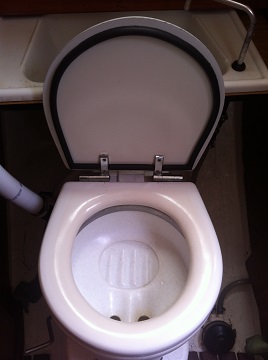 the toilet seat. The fittings that I was able to find were not exactly the same but worked!
the toilet seat. The fittings that I was able to find were not exactly the same but worked!
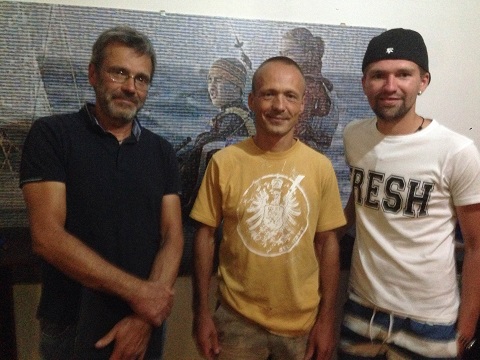
28 June 2014. Xanadu crew
Saturday evening I went to the marina's bar at the far end where the utilities block was to watch the World Cup and at the moment I stepped in, a man asked me in Russian "Arkadi from sailboat Beruta?" It was Alexander Gvozdev, the captain of the Downeaster 38 ketch Xanadu, with whom I exchanged a few emails 2 or 3 years ago regarding rigging and reefing lines. I was surprised. To recognize someone by a photo, which he saw long time ago, must have not been easy! Then I was introduced to his nephew Michael. They organized sailing, diving and hiking tours in the Azores. Here is their Russian website azoresvoyage.com. Very well-made, plenty of information. Given that Alexander had never done anything with a web design before, it was a remarkable debut! He could do anything with a boat, a true handy-man. He showed me his "lady" - very well maintained and renovated! Anyone who go sailing with this captain, would enjoy a hospitality and a comfort of his vessel.
All pictures from this voyage are on Google Photos.
The pictures from Faial island are in a separate album.
Here is the unedited video from this trip on YouTube.

